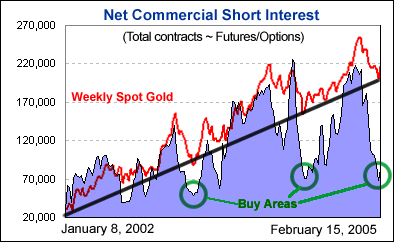|
“The oil exporting countries' central banks ... have been switching out of dollars mainly into euros, and Russia also plays an important role in this. That is, I think, at the bottom of the current weakness of the dollar" George Soros
Shortly after the Soros story crossed the wires the Bank of Korea announced that it was planning to diversify its reserves away from U.S. dollars. These developments, which took place on Holiday Monday, derailed the dollar overnight and had a dramatic impact on many financial markets this morning (i.e. gold/silver rallied strongly, oil jumped above $50 a barrel (due to dollar and cold weather), stocks declined, etc). However, whether or not these developments will have a lasting impact on trade remains to be seen.
News that Soros is bearish on the dollar is not exactly shocking. Rather, Soros is only one of many billionaires – Buffett and Gates being some of the others – that have openly acknowledged they envision a declining dollar. As for the reaction in the FX markets to the Korean announcement – the dollar dropped by more than 1% against both the Euro and Yen – it could be regarded as irrational. After all, so long as Japan and China continue to fund the U.S. current account deficit all is well.
Contrarily, the dollar bear could argue that Soros is a skilled currency speculator and his opinion is important, and news that South Korea – which controls the world's fourth-largest foreign currency reserves and owned $69 billion in Treasury Securities as of December 2004 – is going to diversify reserves away from the dollar is proof that central bankers continue to fear the dollar’s fundamentals. Soros and Korea are evidence that the dollar’s so called ‘tipping point’ (Soros) is near...
Gold Speculations
At the time of this writing spot gold is higher by more than $7 an ounce and is closing in on $435 an ounce. In hindsight, it is can be said that gold was a buy in early February (when COT configurations suggested as much). The same may not be true today.
History has proven that when gold rallies the commercials pad their net short position and await a sell off. The net commercial short ratio as a percentage of open interest has been covered here before, and has marked bottoms/tops in gold will uncanny accuracy since 2002. Similarly, the net short position of the commercials has historically (and just did) marked buying opportunities in gold.
 |
When the above chart is updated later this week it will probably show a sharp increase in net commercial short interest. What this means is that the commercials are playing the same game they have been playing since the gold bull began: that being to short gold in increasing quantities until the price of gold collapses. Incidentally, it goes without saying that if the commercials were to stop betting against gold – the commercials have not been net long gold since December 2001 – the investor would have to immediately buy (more) gold. However, this is not likely to happen anytime soon. Why? Because the commercials will make safe* profits during the next price collapse in gold!
The commercials will not have to concede *until the dollar crisis many have been prophesizing comes to pass. Accordingly, the real gold bull market – or when gold will start rising against all currencies after the dollar reaches its tipping point – will only be marked by commercial defaults and panic short covering. Anything less than panicked defaults is a gold rally with limits.
In short, a gold rally sparked by the reserve actions of the South Korea - and not Japan or China - is a rally with limits. As for when these limits will be broken, that is a question many h |